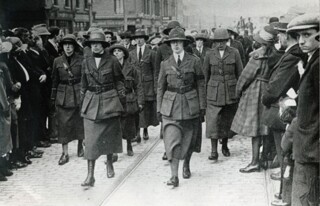Sorry, Mrs O’Duffy
Anakana Schofield
I should like to apologise to Brigid O’Duffy (née Davis), who served in the Irish Citizen Army during the Easter Rising in 1916 but did not see her military pension until 1937. Her pension application (MSP34REF20583 in the recently digitised Military Service Pensions Collection) is date-stamped December 1936 by the Department of Defence. The files of 433 other women have also been unveiled.
The 1924 Military Pension Act, ‘to provide for the payment of military service pensions to certain members and former members of the national forces and the defence forces of Saorstát Eireann’, made no provision for women, regardless of their contribution to the fight for independence. It wasn’t until the 1934 Military Pension Act that Cumann na mBan, the women’s revolutionary movement, was named in the forces schedule. But women who were not engaged in ‘armed activities’ were still excluded: those who had administered first aid, provided food, run guns, stored ammunition, delivered messages, performed reconnaissance. More than 200 women took part in the Easter Rising, and there were women stationed at every Dublin garrison except Bolands Mill (De Valera ‘didn’t approve’). Forty were holed up inside the GPO.
Brigid O’Duffy (I’ve chosen her at random) was born in 1891 and died in 1954. According to her pension application form she served on 23 and 24 April 1916 at City Hall and the attack on Dublin Castle. She was the second in charge in the medical section, under the chief medical officer, Dr Kathleen Lynn. After surrendering she was interned at Ship Street Barracks and then moved to Kilmainham. The jail had lain empty for 16 years and was the penal equivalent of a dirty cave. Fearghal McGarry’s Rising: Easter 1916 (2010) describes a toilet in a dry closet with no door, which women prisoners were escorted to by drunk British soldiers armed with bayonets. O’Duffy was interned along with 70 other women from 24 April to 9 May, when she was released unconditionally. John Maxwell, the British military governor, was busy executing the male leaders of the uprising and considered the women ‘silly girls’ (five of them were sent to prison in England all the same).
Asked for ‘particulars of any military operations or engagementes or services rendered during the period’ before and after the uprising, O’Duffy wrote: ‘attending Col. Hanratty 2 weeks prior to 23 April for wounds received in Liberty Hall’. I imagine Hanratty would have thought she deserved her military pension.
After waiting almost 20 years for the right even to apply for it, the women had to further endure the process by which their applications were assessed. The application form is lengthy, printed on eye-straining beige paper (perhaps it’s faded) and asks for references. This created even more work for Dr Lynn, who in 1919 had established St Ultan’s, the first children’s hospital in Dublin, and according to her biographer Margaret Ó hÓgartaigh was on call 24 hours a day. Lynn’s letter of support for O’Duffy confirms that she was her ‘principal’ helper ‘during the preparations for Easter Week 1916’ and concludes: ‘Mrs O’Duffy was always a most devoted helper for the cause.’
In her sworn statement made before the advisory committee in December 1936, O’Duffy described holding the roof of Liberty Hall with Helena Molony and two other women in May 1917, on the first anniversary of James Connolly’s execution by the British: ‘We barricaded the place. There were four of us taking part in that only... it took hundreds of them to take four of us off the roof.’ It if took hundreds of them to take her off the roof, there must have been hundreds of witnesses. But everything had to be triple-checked all the same.
In her reference for O’Duffy, Molony wrote:
She was posted on the roof of City Hall during Easter Monday – a position of great danger. She acquitted herself with great coolness and courage, being several times under fire. Ultimately she was taken prisoner, and detained in Ship St Barracks.
Molony later wrote Sean O’Faolain a letter in which she took him to task for his depiction of Constance Markievicz:
It is a curious thing that many men seem to be unable to believe that any woman can embrace an ideal – accept it intellectually, feel it as a profound emotion, and then calmly decide to make a vocation of working for its realisation. They give themselves endless pains to prove that every serious thing a woman does (outside nursing babies or washing pots) is the result of being in love with some man, or disappointed in love of some man, or looking for excitement, or limelight, or indulging their vanity.

Comments
Nice post.